Devil's Hideout review

- 0 Comments
A short but captivating occult mystery lies waiting in Cosmic Void’s latest retro pixel art thriller
With his third release already this year, solo developer Cosmic Void is on the rise with his prolific adventure game development, quite like the “Dark Sun” prophesied in his latest creation, Devil’s Hideout. This excellently voiced point-and-click occult mystery depicts a nightmare come to life in pixel art form. It’s a short game whose abrupt ending might leave you hanging like a serial killer’s victim on a butcher shop’s meathook, but it’s a well-written story while it lasts, with inventory puzzles to keep you busy searching and a few nicely integrated yet basic mini-games for variety.
Exactly one year earlier, while on a road trip, Lauren and her younger sister Beth were victims of a car accident and were rushed to a local hospital. Lauren got patched up, but sadly Beth didn’t make it. Naturally, Lauren has had trouble letting her sister go, as the whole tragedy keeps smoldering in her mind. So much so that doubts start infecting her rationality and she arranges an exhumation. When that uncovers an empty grave, without any sign of Beth, Lauren calls in the help of a medium to track down the spirit of her supposedly dead sister.
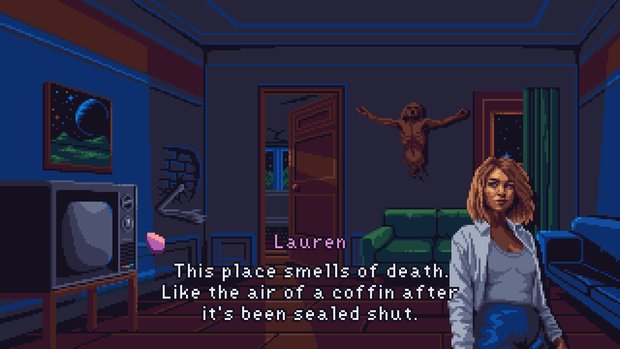
Devil’s Hideout starts with a beautiful full-screen portrait of this psychic. Her nasal voice makes her sound a bit bored and haughty, but she certainly succeeds in making Lauren –brought completely to life by the talented Ivy Dupler – sound extremely anxious about Beth. The psychic tells Lauren that, contrary to what she’d been led to believe, her sister is still dangling between life and death, her fate in the hands of a satanic cult that has a complete hold of the town where the girls had their accident. So Lauren heads back to the hospital that treated them, together with her friend Atticus, in search of her abducted sister.
It’s a great premise for an adventure game, in a narrative genre I prefer: that of an ordinary person suddenly confronted with an extraordinary situation in an everyday, realistic setting instead of taking place in a fantasy or futuristic world. Because the setting here is so recognizable, so familiar, it makes it all more tangibly disturbing when things turn increasingly dark and bizarre.
It’s in front of the hospital that we take control of Lauren. The scenes are presented from a static first-person viewpoint, yet Lauren herself often appears when she’s talking to other characters. During dialogue, their portraits all seem to pop up from the bottom of the screen, almost like cardboard cutouts held up by some puppeteer. But there’s nothing silly about them; they all have detailed designs, very subtle animations, and natural-sounding voice actors – and when it comes to the townsfolk, possess just the right touch of creepiness.
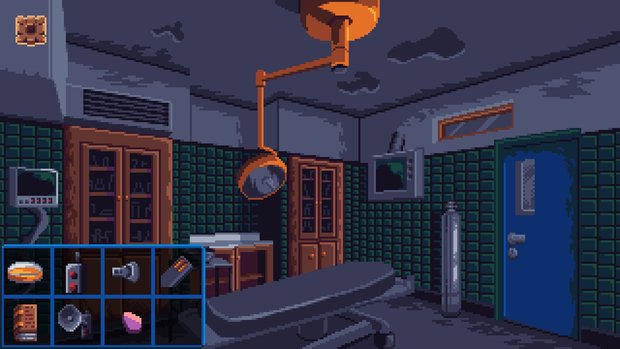
Lauren’s friend Atticus joins her in the search, and though we never learn much about him, he has the appearance of a no-bull police detective. There’s also local boy Callum, who tries to help Lauren and does look a bit silly in his top hat, which is only there because you need it for a puzzle later on – if you succeed in tracking him back to his apartment, that is. There’s a store clerk perfectly willing to sell you some items you need, and a terrifying clown hungry for human flesh guarding certain locations, so you’ll need to get rid of him, first by figuring out his name.
Regularly, a cloaked stranger shows up on the streets to instill some more fear into Lauren with talk of the cult and their prophecy of their Dark Sun god Ru’u descending down on earth, with Beth needed as a human sacrifice to accomplish it. However, these are just cutscenes without any interaction needed from the player. In fact, Devil’s Hideout doesn’t feature any dialogue trees at all. But I didn’t regard that as a flaw, as the writing of these cutscenes – as well as Lauren’s internal dialogue when commenting on everything she observes – is so on point that it keeps up the rhythm of the story without any unnecessary diversions.
The user interface consists of a simple one-click system. The cursor will change into a red orb when you hover over an active hotspot; clicking will either give a description of the object, or Lauren will pick it up or manipulate it. Helpfully, the orb will turn blue once you’ve exhausted all of a hotspot’s options, so you know you’re done with it. You can still click to get a repeat of Lauren’s last response if you so wish, in case you think you might have missed something. Very occasionally, this also happens when the orb cursor remains red, which should promise more options but appears to just be an oversight. Still, I found the color coding to be a very helpful visual aid, to tick off all steps in my exploration of a scene. But don’t be fooled: even when a hotspot is flagged as “done,” you might still need to return to it for a puzzle later on. In dark rooms, an automatic flashlight beam will only illuminate a small region around the cursor, and you’ll have to scour the location for hotspots this way, adding to the tension of possible encounters with any nasty business lurking there.
There’s an inventory icon in the bottom left corner of the screen. There you can click on an item to use it on another or a hotspot, but the description of inventory items is limited to a short label when you hover over them. You can’t closely examine items you’ve picked up, but none hide any further secrets or puzzles of their own. A nice touch is that when somebody is near you and might be able to help with something – like Lauren’s friend Atticus – their face will be added to your inventory for you to “use” them as well, which is good for a few funny replies.
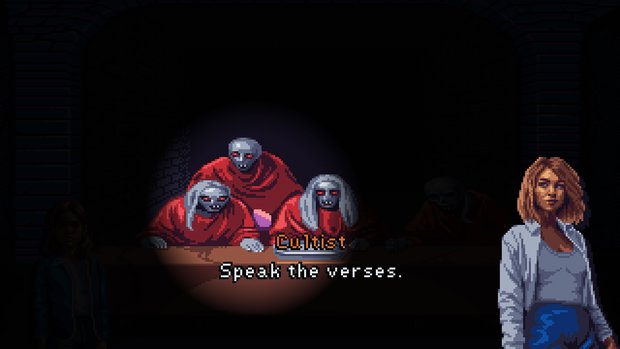
The puzzles are relatively easy, though I encountered a few head scratchers, mostly to figure out where exactly to use an item in locations visited much earlier. For instance, at one point I found an audio cassette, but I didn’t immediately recall where I would be able to listen to it. It wasn’t even directly referenced earlier, so I just had to surmise that specific hotspot offered the needed playback capabilities.
Sometimes you’ll encounter logic puzzles or short mini-games. You’ll have to win a game of Blackjack against Callum, decipher a code by correctly linking symbols to abstract concepts (such as a set of scales standing for “justice”) to open a strongbox, and turn off all lights in a grid where turning off one relights others. There aren’t many of them, but they come at well-spaced intervals and they feel well-integrated into the story, so I enjoyed the variety they brought to the gameplay.
Devil’s Hideout has a great soundtrack of spooky 80s synthesizer tracks coupled with organ-like samples and even some church bells thrown in to achieve a fittingly creepy vibe. There are loads of jump scares in the form of ghostly faces suddenly appearing in front of you when you switch locations, accompanied by loud musical sound effects to completely scare you out of your seat in need of some drier vestimentary replacements. But these are only there for the effect instead of really adding anything to the story, and you’re never in any real danger. The faces actually belong to the game’s Kickstarter backers; you’ll similarly find a magazine filled with short horror stories written by other supporters.
The search for Beth takes you from the hospital to a subway station, a couple of apartment buildings, a convenience store, a butcher shop and a strange field just outside of town. You can travel between destinations by means of a very basic, almost monochromatic overview map, with the available locations indicated as red-lined boxes between the other, inactive blue buildings. Each environment features rust-colored undertones, with buildings looming over you, their steep, extreme slanting angles seeming to threaten to topple over on top of you. There’s a constantly colorful starry sky above, with some weird-looking blood red clouds that seem to be on fire. You will often encounter graphically disturbing scenes, like mutilated human bodies, but these fit in better narratively and aren’t just there for shock value.
As you progress, you will learn more and more about the cult and their strange prophecy for which they need Beth. There’s plenty of evidence that there are indeed weird things going on in this town, but the focus always remains on finding and saving Lauren’s sister, not on taking down the cult. It’s a gripping story that moves along briskly, but I was surprised when the game finished. You can complete it in less than three hours, and I didn't see the end coming. I guess I was expecting a bit more to it, something more of a final showdown perhaps. Instead, Cosmic Void leaves to our imagination what happens next, so you’ll have to make up your own mind whether the cult is just a group of crazy people or if there really is something to their prophecy.
Final Verdict
Although Devil’s Hideout is a short game, this developer definitely knows how to keep his audience glued to the screen. There’s never a dull moment, always with one puzzle or other to solve, alternating with some thankfully non-frustrating mini-games and gorgeously horrific locations to explore, filled with creepy characters that seem to have walked straight out of a horror movie. Lauren is a great heroine, a strong woman who will do anything to save her sister, though she still gets scared and freaked out by the crazy stuff she encounters. The “fan service” jump scares never stopped getting to me, which did get a bit annoying in the end if I’m totally honest. While at first I was baffled by the sudden ending, it hit me not long after that the writer wanted to subtly hint at a possible hidden truth without outright stating it as fact, keeping the player guessing, which I can appreciate. It might leave you yearning for a firmer resolution, but in its own way it nicely wraps up a well-written horror tale where the devil can be hiding around every corner.
Hot take
Cosmic Void succeeds in delivering another compelling mystery, as the frights in Devil’s Hideout challenge your courage and puzzle-solving skills in this short but spooky point-and-click occult adventure.
Pros
- Well-written short story-length horror tale
- Spooky soundtrack fits the consistently scary town
- Integrated mini-games introduce some gameplay variety
- Detailed character designs perfectly brought to life by an excellent voice cast
Cons
- Jump scares are unrelated to the story and used purely for shock effect
- Lacks a grand finale, resulting in a sudden conclusion of the story
Johnny played Devil’s Hideout on PC using a review code provided by the game’s publisher.


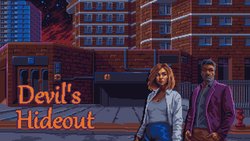

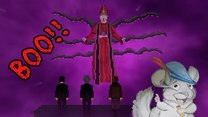






0 Comments
Want to join the discussion? Leave a comment as guest, sign in or register in our forums.
Leave a comment